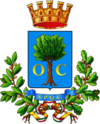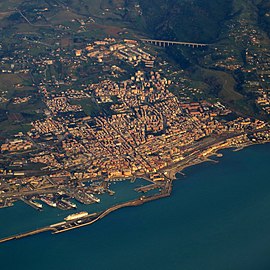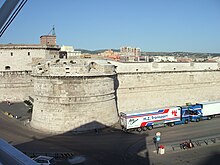Civitavecchia
| Civitavecchia | ||
|---|---|---|

|
|
|
| Country | Italy | |
| region | Lazio | |
| Metropolitan city | Rome (RM) | |
| Coordinates | 42 ° 6 ′ N , 11 ° 48 ′ E | |
| height | 4 m slm | |
| surface | 72 km² | |
| Residents | 52,806 (Dec. 31, 2019) | |
| Population density | 733 inhabitants / km² | |
| Post Code | 00053 | |
| prefix | 0766 | |
| ISTAT number | 058032 | |
| Popular name | Civitavecchiesi | |
| Patron saint | St. Fermina | |
| Website | Civitavecchia | |

|
||
Civitavecchia is an Italian city in the metropolitan city of Rome in the Lazio region with 52,806 inhabitants (as of December 31, 2019). It is the most important port city in the Lazio region.
geography
Civitavecchia is 69 km northwest of Rome and 244 km southeast of Livorno . The area of the city extends in a plain along the Tyrrhenian Sea and the Via Aurelia between the rivers Mignone in the north and Marangone in the south. In the northeast it extends into the foothills of the Tolfaberge . The townscape is determined by the port, the largest seaport in Lazio. It used to be the naval port of the Papal States .
The community is located in earthquake zone 3 (little risk).
The municipality includes the districts Aurelia and Scaglia north of the city center. The municipality extends over a height of 0 to 439 m slm
The neighboring municipalities are, clockwise, Tarquinia ( VT ), Allumiere and Santa Marinella ,
traffic
-
 Civitavecchia has two exits on the A12 Autostrada Azzurra, Rome - Genoa , the southern part of which ends on the northern outskirts. In 2011, the construction of the motorway to Tarquinia began and in the foreseeable future the gap to the northern part, which currently ends south of Livorno, will be closed.
Civitavecchia has two exits on the A12 Autostrada Azzurra, Rome - Genoa , the southern part of which ends on the northern outskirts. In 2011, the construction of the motorway to Tarquinia began and in the foreseeable future the gap to the northern part, which currently ends south of Livorno, will be closed. -
 Until then, long-distance traffic runs on the Strada Statale SS1 Via Aurelia .
Until then, long-distance traffic runs on the Strada Statale SS1 Via Aurelia . -
 Civitavecchia train station is on the Pisa – Rome railway line and is also the terminus of the FL5 regional train from Roma Termini .
Civitavecchia train station is on the Pisa – Rome railway line and is also the terminus of the FL5 regional train from Roma Termini . -
 Ferries to Sardinia , Sicily and Corsica leave from the port of Civitavecchia .
Ferries to Sardinia , Sicily and Corsica leave from the port of Civitavecchia . -
 The nearest international airport, Rome Fiumicino, is 63 km away.
The nearest international airport, Rome Fiumicino, is 63 km away.
history
Civitavecchia is believed to be a foundation of the Etruscans . But it was not until Emperor Trajan , who built the port in 107 to 110 AD, that the place developed into a city under the name Centumcellae . In the 4th century at the latest it became a bishopric. 416 described Rutilius Centumcellae as the only still flourishing city on the coast north of Rome. From the 6th to the 8th centuries, the city was under the control of Byzantium .
In the year 812 the Saracens destroyed Centumcellae and occupied it in the following years as a bridgehead for actions in central Italy. It was only with the naval battle of Ostia in 849 that this danger could finally be averted. Pope Leo IV relocated the population in 854 to an easier-to-defend hill north of the city. He named the new city Leopoli . However, the ancient name in the simplified form Cencelle quickly caught on again. The ruins of the city, especially its city wall, can still be seen at Allumiere today .
Only around the year 1000 was the area at the old port around a castle repopulated and was given the name Civitavetula , meaning old town . The city was under the rule of the Counts of Civita Castellana , or the Abbey Farfa until 1432 finally to the Papal States came, where they remained until the unification of Italy (1870).
During the Second World War , Civitavecchia was reduced to rubble by Allied air forces, despite the fact that it was a stronghold of the Italian resistance, the Resistancea .
politics
Mayor and City Council
Pietro Tidei ( PD ) was in the runoff on 20/21. Elected Mayor in May 2012. He defeated his predecessor Giovanni Moscherini ( PdL ) with 52.7%. Tidei's center-left coalition provided the majority in the local council with 15 out of 24 seats. Tidei was mayor of Civitavecchia from 1994 to 2001 and mayor of the neighboring town of Santa Marinella from 2005 to 2007. Because the coalition supporting him broke up in November 2013, he announced his resignation.
In the new election in June 2014, Antonio Cozzolino ( M5S ) defeated Pietro Tidei in the runoff election with 66.6% to 33.4%. MoVimento 5 Stelle provided 15 of the 24 municipal councils. Ernesto Tedesco (coalition of right-wing parties) won the election on May 26, 2019.
Mayor of Civitavecchia:
- 1994-2001: Pietro Tidei ( DS )
- 2001–2005: Alessio De Sio, ( center-right alliance )
- 2005–2006: Angelo Di Caprio, acting mayor
- 2006–2007: Giuseppe Saladini, ( center-left alliance )
- 2007–2012: Giovanni Moscherini, ( PdL )
- 2012–2013: Pietro Tidei ( PD )
- 2013–2014: Ferdinando Santoriello, acting mayor
- 2014–2019: Antonio Cozzolino ( M5S )
- from 2019: Ernesto Tedesco (right-wing coalition)
coat of arms
Blue shield with oak in natural colors. The trunk is flanked by the golden letters O and C. Underneath the motto SPQC . According to a legend, the residents of Leopoli are said to have gathered under an oak tree, where an old seafarer gave them the advice (best advice = Ottimo Consiglio, hence the letters OC) to settle the ruins of the old port city again.
Town twinning

Population development
| year | 1871 | 1901 | 1921 | 1936 | 1951 | 1971 | 1991 | 2001 | 2011 |
| Residents | 9,718 | 15,220 | 20,635 | 27,477 | 32,870 | 44,188 | 51,201 | 50.032 | 51,261 |
|---|
Source ISTAT
Sightseeing and tourism
- The fortress Forte Michelangelo was started by Donato Bramante on behalf of Pope Julius II . After his death, the building was completed by Giuliano Leno , Antonio da Sangallo and finally the eponymous Michelangelo . It is the massive landmark of the city, right on the harbor.
- The Taurin thermal baths or Therme des Trajan are an excavation site near the motorway exit Civitavecchia-Nord . According to legend, a bull scratched the ground with its hooves and discovered the warm thermal water that gave the impetus for the construction of the thermal baths in ancient times. Trajan , who was here as well as Marcus Aurelius , expanded the building complex. Close by are the modern Ficoncella thermal baths , which are often the destination of capital city dwellers in need of relaxation .
- In the south of the city is the leisure port Riva di Traiano with over 1100 berths.
- Fortino di San Pietro , the remains of an ancient lighthouse, dates from around 110 .
religion
The majority of the inhabitants of Civitavecchia belong to the Roman Catholic religious community. The city is the seat of the diocese of Civitavecchia-Tarquinia with the Cathedral of San Francesco d'Assisi . The diocese of Centumcellae was founded in the 4th century at the latest, but became part of the Toscanella diocese in the 11th century . In 1825 the diocese was gregis with the Bull De Dominici by Pope Leo XII. restored.
In 1995 an allegedly mystical phenomenon occurred. A statue of the Virgin is said to have cried bloody tears several times. The Madonna figure was transferred to the St. Augustine Church and is on display there.
education
Civitavecchia is home to the University of Tuscia with the Faculty of Mathematics, Physics and Natural Sciences and the University of La Sapienza with the Faculties of Medicine, Economics and Engineering.
economy
The city's economy is mainly based on the port , which is of exceptional transport importance for both the city of Rome and the Lazio region . It has a modern passenger terminal which, in addition to ferry traffic to Sardinia , Sicily , Spain and France, is used to handle a steadily growing cruise business. Several shipping companies serve the port: GNV operates to Palermo and Tunis , Tirrenia to Arbatax in Sardinia, Cagliari and Olbia, Moby Lines and Sa.re.mar to Olbia.
Culinary specialties
Civitavecchia is famous for the digestif Sambuca , which is made here by the traditional companies Manzi and Molinari . The name may derive from the Arabic zammoth , which referred to a drink based on anise and was landed here on ships as part of the Levant trade from the Orient.
sons and daughters of the town
- Cornelius († 253), Bishop of Rome
- Luigi Calamatta (1801–1869), Italian engraver, draftsman and Knight of the Legion of Honor
- Alberto Guglielmotti (1812-1893), Italian naval historian
- Guglielmo Nasi (1879–1971), Italian general
- Silvio Branco (* 1966), Italian boxer
- Roberto Petito (* 1971), Italian racing cyclist
- Manuele Blasi (* 1980), Italian football player
literature
- Christof Henning: Latium. The land around Rome. With walks in the Eternal City (= DuMont art travel guide ). 3rd, updated edition. DuMont, Cologne 2006, ISBN 3-7701-6031-2 .
- Mark Twain : The innocent abroad (= Mark Twain's adventure. In five volumes. Vol. 4 = Insel-Taschenbuch 1894). Insel-Verlag, Frankfurt am Main et al. 1997, ISBN 3-458-33594-3 .
Web links
- Civitavecchia on www.comuni-italiani.it (Italian)
- Harris, W., DARMC, R. Talbert, S. Gillies, T. Elliott, J. Becker: Places: 413076 (Centum Cellae) . Pleiades. Retrieved on July 12, 2015 11:27 am.
- Website of the city of Civitavecchia (Italian / English)
- Port of Civitavecchia (English)
- Cencelle (Italian)
References and comments
- ↑ Statistiche demografiche ISTAT. Monthly population statistics of the Istituto Nazionale di Statistica , as of December 31 of 2019.
- ^ Italian civil defense
- ^ Christian Hülsen : Centum Cellae. In: Paulys Realencyclopadie der classischen Antiquity Science (RE). Volume III, 2, Stuttgart 1899, Sp. 1934-1934. [1]
- ^ Edward Herbert Bunbury: Centumcellae . In: William Smith : Dictionary of Greek and Roman Geography. London 1854.
- ^ Information from the Ministry of the Interior , accessed on May 23, 2012
- ↑ viterbonews24.it (Italian) accessed on July 12, 2015
- ^ La Repubblica (Italian) accessed on July 12, 2015
- ↑ lazionascosto.it (Italian) accessed on July 12, 2015
- ↑ Bethlehem Twinning Cities (english)
- ↑ Statistiche demografiche ISTAT . Population statistics from the Istituto Nazionale di Statistica, as of December 31, 2011.
- ↑ When the Madonna wept bloody tears. Retrieved February 25, 2018 .
- ↑ Italy: Bad idea . In: Der Spiegel . tape April 15 , 10, 1995 ( spiegel.de [accessed February 25, 2018]).
-
↑ Twain mentions Civitavecchia in his travelogue from 1869:
"This Civita Vecchia is the finest dirt nest and domicile of vermin and ignorance ... These alleys are paved with stones and covered with a carpet made of dead cats, rotted rags, rotted vegetable waste and There is leftover old shoes, everything is soaked in rinse water, and people sit around on stools and enjoy it ... Some of the men join the military, the others become priests and the rest become cobblers ... There is nothing to see here " .




